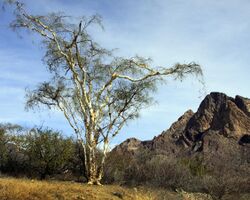Biology:Mariosousa heterophylla
| Mariosousa heterophylla | |
|---|---|

| |
| Scientific classification | |
| Kingdom: | Plantae |
| Clade: | Tracheophytes |
| Clade: | Angiosperms |
| Clade: | Eudicots |
| Clade: | Rosids |
| Order: | Fabales |
| Family: | Fabaceae |
| Subfamily: | Caesalpinioideae |
| Clade: | Mimosoid clade |
| Genus: | Mariosousa |
| Species: | M. heterophylla
|
| Binomial name | |
| Mariosousa heterophylla (Rose) Seigler & Ebinger[1]
| |
| Synonyms[1][2] | |
| |
Mariosousa heterophylla, also called the palo blanco tree (which is also applied to Ipomoea arborescens),[3] palo liso, guinola,[4] and Willard acacia, is a normally evergreen mimosoid plant in the genus Mariosousa native to Mexico. The Spanish common name translates into 'white stick', defining its peeling white bark. A compound called willardiine, that acts as an agonist in glutamate receptors, can be isolated from M. heterophylla.[5][6]
Description
It can grow 10–20 ft or more with a spread of 1⁄3 to 2⁄3 the height. It is a very slender tree with few branches as well as leaves. The petiolar-rachis is characteristically long and functions as a cladophyll. it has a white or yellow-colored peeling off bark. The leaves have 5–6 leaflets in the end. It may drop leaves in autumn and winter. The flowers are like catkins, rod or bottle-brush-like, white or light yellow in color. The pods are multichambered, and 3–4 in long specimens.[7] The flowers occur in pale yellow spikes.[8]
Distribution and habitat
The plant is endemic to Sonora (Sonoran desert), Mexico. It prefers rocky bajdas, slopes and arroyos from 0 to 2,000 feet elevation.[9] It is a popular ornamental tree in arid areas, especially in the southwestern U.S.[10]
References
- ↑ 1.0 1.1 "New Combinations in Parasenegalia and Mariosousa (Fabaceae: Mimosoideae)". Phytologia 100 (4): 256–259. 2018. https://www.phytologia.org/uploads/2/3/4/2/23422706/100_4_256-259seiglerebingernewcombin_parasenegallia_and_mariosousa12-21-18.pdf.
- ↑ "Mariosousa, a New Segregate Genus from Acacia s.l. (Fabaceae, Mimosoideae) from Central and North America.". Novon 16 (3): 413–420. 2006. doi:10.3417/1055-3177(2006)16[413:MANSGF2.0.CO;2]. http://www.bioone.org/doi/abs/10.3417/1055-3177%282006%2916%5B413%3AMANSGF%5D2.0.CO%3B2.
- ↑ Phillips, S. J.; Patricia Wentworth Comus (2000) (PDF). A natural history of the Sonoran Desert. Arizona: Arizona-Sonora Desert Museum Press. p. 230. ISBN 0-520-21980-5. https://books.google.com/books?id=Lb5I0tcnYNkC&dq=Acacia+willardiana&pg=PA230.
- ↑ Dimmitt, M. A.. "Acacia willardiana". Arizona-Sonora Desert Museum. ASDM Sonoran Desert Museum Digital Library. http://www.desertmuseumdigitallibrary.org/public/detail.php?id=ASDM09608&sp=Acacia%20willardiana.
- ↑ Klaassen, C. D.; John Barr Watkins (2010). "Toxic Agents". Casarett and Doull's essentials of toxicology. USA: McGraw-Hill Prof Med/Tech. p. 374. ISBN 978-0-07-176651-7. https://books.google.com/books?id=lqE5RW-nvhsC&dq=Acacia+willardiana&pg=PA374.
- ↑ Atta-ur- Rahman (2000). "Interference of Alkaloids". Bioactive Natural Products (Part B), Part 2. Amsterdam: Alsevier Science B. V.. p. 72. ISBN 9780080542010. https://books.google.com/books?id=tWEFrc7EfRgC&dq=Acacia+willardiana&pg=PA72.
- ↑ Moore, Tony. "Acacia willardia, Palo blanco, Fabaceae Family". Government of Arizona. http://ag.arizona.edu/pima/gardening/aridplants/Acacia_willardiana.html.
- ↑ Jaeger, E. C. (1957) (PDF). The North American deserts. California: Stanford University Press. p. 256. ISBN 0-8047-0498-8. https://archive.org/details/northamericandes00jaeg. "Acacia willardiana."
- ↑ {{citation | mode = cs1 | title = Mariosousa heterophylla | work = Germplasm Resources Information Network (GRIN) | url = | publisher = [[Organization:Agricultural Research ServAgricultural Research Service (ARS), United States Department of Agriculture (USDA) | access-date = 23 January 2018 }}
- ↑ "Great Design Plant: Palo Blanco Softens Sharp Desert Angles". http://www.houzz.com/magazine/Great-Design-Plant-Palo-Blanco-Softens-Sharp-Desert-Angles-stsetivw-vs~16164425.
Wikidata ☰ Q4671022 entry
 |



